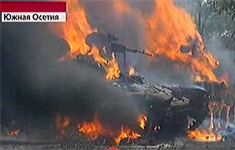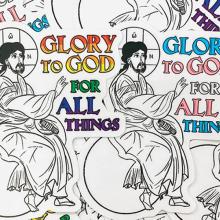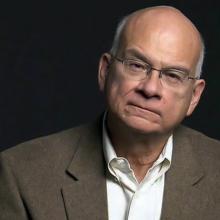Orthodox Church
ACCORDING TO AN Orthodox miracle story, St. Nicholas — the fourth century archbishop who inspired the figure of Santa Claus — quieted a raging sea. When sailors were caught in a storm on the Mediterranean, they called out for help. Nicholas appeared, walking on the waves before them. He blessed the ship, and the storm calmed. This is why he became the patron saint of sailors. It’s also why Mary Marza, a queer Orthodox artist in her mid-20s who is based in Los Angeles, illustrated St. Nicholas as a “waterbender.” Waterbenders, from the animated series Avatar: The Last Airbender, can control water and its movements. This is one of many works featured on her Instagram art account, Art of Marza.
“I liked the concept of blending saints with the elements or just blending the saints with things from my favorite stories and pop culture,” Marza wrote in an Instagram caption about this portrayal of St. Nicholas.
Marza (who asked to use her art account name instead of her real last name for this article) creates digital art and stickers that blend Orthodox iconography and prayer with street art and anime. The grungy, graffiti-and-animation-inspired aesthetic of her art and its confluence with iconography is part of her longing to “[see] God in places where people assume we can’t find Him,” she wrote on Instagram.
UKRAINE IS, IN A WAY, a very pluralistic country. Nobody has an absolute majority. The Orthodox are the biggest group of believers, but they are divided into two jurisdictions — one that is independent and another one that depends, to a bigger or smaller degree, on Russia and the patriarchate of Moscow. Around 10 percent of the Ukrainian population are Catholic, mostly Eastern Catholic, and follow the same calendar and liturgy as the Orthodox. One to 2 percent are Latin Rite Catholics, and 1 to 2 percent are Protestant.
Put is committed to see the glories and geography of “Mother Russia” restored. Religiously, he claims this is preserving “Christian civilization” against the secular decadence of the West. And for that, his transactional alliance with the Russian Orthodox Church is essential. Like the czars, he wants to see Moscow as the center of political and military power over an empire that is sanctified by the blessing of the Russian Orthodox Church. And he wants an Orthodox Church he can control to reign in Ukraine.
Since the Russian Supreme Court labeled Jehovah’s Witnesses an “extremist” group, vandals have targeted followers and their banks accounts have been frozen. Stones were thrown at a St. Petersburg assembly hall, and someone tried to burn the Moscow home of a Jehovah’s Witness to the ground, a church spokesman said.
As the seminary said in announcing the award, Keller “is widely known as an innovative theologian and church leader, well-published author, and catalyst for urban mission in major cities around the world.”
But Keller is also a leader in the Presbyterian Church in America, or PCA, which is the more conservative wing of U.S. Presbyterianism and does not permit the ordination of women or LGBTQ people.
FRANCISCAN BROTHER ROBERT LENTZ is a contradictory blend of traditional and tradition-challenging. That same surprising mix could be said to typify his contemporary approach to the ancient art of iconography.
Brother Robert’s work adorns cathedrals, churches, and homes of many faiths, though his name may not ring a bell, even among his fans.
But describe his icons of Martin Luther King Jr. or César Chávez, his portrayals of Jesus as black, Korean, and Navajo, and his non-Christian subjects including Mohandas Gandhi and the Sufi mystic Rumi, and the response may be “Oh, yes! I have one of those.”
Icons—religious paintings used as aids in Christian prayer—have been called a “doorway into the kingdom of heaven.” Brother Robert’s icons are striking, often for the contemporary twists in classically structured images, such as the army canteen held by St. Toribio Romo, a 20th century Mexican priest who is revered as the patron of migrants crossing the border. His Chávez image carries a copy of the Constitution and wears a sweatshirt with the United Farmworkers logo. “Icons may contain anachronisms,” he said, “when there is a great truth at stake.”
Brother Robert’s work—and his life—seem often to focus on such anachronisms in pursuit of truth. At 67, he is a Roman Catholic Franciscan brother in the New York-based Holy Name Province, living and working in a studio created for him in the order’s seminary near Washington, D.C. A religious brother is not a priest, though he lives by the vows of poverty, chastity, and obedience and dedicates his life to charitable service. It’s Brother Robert’s second stretch as a Franciscan, the order founded by St. Francis of Assisi. But it’s his third stint in religious life, having also come close to ordination as a priest in the Russian Orthodox Church Outside of Russia.
 The recent Georgia-Russia mini-war in and around South Ossetia was definitely not a religious war, but it serves as a reminder that religious identity doesn't even come in third place when issues of national identity are at issue. While the battle raged, the majority of participants -- and casualties -- were Christians on both sides.
The recent Georgia-Russia mini-war in and around South Ossetia was definitely not a religious war, but it serves as a reminder that religious identity doesn't even come in third place when issues of national identity are at issue. While the battle raged, the majority of participants -- and casualties -- were Christians on both sides.
In both countries, the Orthodox Church [...]
'How many of you are both pro-life and against the death penalty?'






